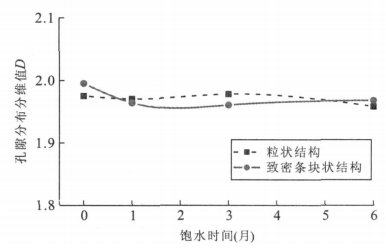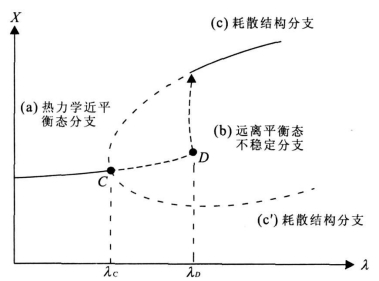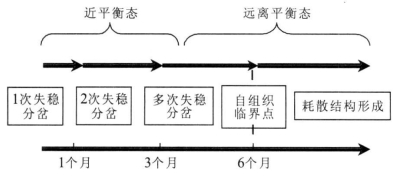Forming Mechanism of Dissipative Structure in the Softening Process of Saturated Soft Rocks
-
摘要: 针对华南“红层”软岩遇水软化的复杂系统演化问题, 从其软化过程中是否形成耗散结构的思路出发, 研究了软岩系统非线性软化特征.结果表明: 软岩与水相互作用系统是一个开放的复杂系统, 在内部非线性作用下逐渐演化至非平衡状态, 其软化过程中可以形成有序的耗散结构.在此基础上, 采用耗散结构理论系统分析了软岩软化过程中耗散结构的形成机制: 软岩软化的过程经历了近平衡态、远离平衡自组织态与远离平衡临界态3个阶段, 并最终通过非平衡相变形成了具有一定稳定性的耗散结构.最后基于软岩软化过程中结构分维值演化规律, 初步建立了软岩耗散结构形成的分岔演化模型, 并将模型应用于软岩饱水软化试验的临界分岔现象分析中.分析表明软岩耗散结构是在系统经历多次倍周期分岔, 通过不断地从稳定到失稳再到稳定的过程后形成的.其中3个月与6个月这两个时间点具有显著的临界特征, 这是深入研究软岩软化耗散动力学过程的切入点.Abstract: Aiming at the complex issue of system evolution in softening process of saturated red-bed soft rocks, the research on softening characteristics of soft rocks is carried out from the aspects of systemic openness, far-from equilibrium behavior and internal nonlinear mechanism to affirm the occurrence of dissipative structure in softening process.On this basis, dissipative structure theory is adopted to systematically analyze the formation mechanism of dissipative structure in softening process of saturated soft rocks.The result shows that softening process contains three stages: Near-equilibrium state, far-from-equilibrium self-organizing state and far-from-equilibrium critical state, and ultimately, the way of non-equilibrium phase transition leads to the generation of soft rock dissipative structure.Finally, based on the evolution law of structure fractal dimension, a bifurcation evolution model is preliminarily established to describe the formation process of soft rock dissipative structure.The result of applying this model to analyze the critical bifurcation phenomena occurring in softening tests of saturated soft rocks indicates that this soft rock dissipative structure is formed after experiencing the process of period-doubling bifurcation and destabilization for many times, and the times of three months and six months present obvious critical characteristics which are two breakthrough points for further study on dissipative dynamic softening process of soft rocks in future.
-
Key words:
- soft rocks /
- softening /
- dissipative structure /
- non-equilibrium phase transition /
- critical bifurcation /
- mechanism
-
图 4 Logistic离散动力演化系统的迭代过程(谢应齐和曹杰,1995)
Fig. 4. Iterative process of Logistic discrete dynamic system
图 5 Logistic系统演化的分岔行为(谢应齐和曹杰,1995)
Fig. 5. Bifurcation behavior of Logistic system evolution
表 1 不同饱水时间下软岩相关参数
Table 1. Parameter table of soft rocks in different saturation times

表 2 Logistic方程指标计算结果
Table 2. Calculation results of Logistic equation index

表 3 动力学参数随时间的内插值
Table 3. Interpolation data of dynamic parameters with time

表 4 饱水3个月与6个月时间点临界特征
Table 4. Critical characteristics after 3 and 6 months saturation

-
Bak, P., 1999. How nature works: The science of self-organ-ized criticality. Copernocus Press for Springer-Verlag, New York. Cai, S. H., Peng, S. Z., Zhao, X. R., et al., 1998. Dissipation structure and non-equilibrium phase theory and application. Guiyang Science and Technology Press, Guiyang (in Chinese). Chen, J. P., 2001. Towards understanding of dissipative structure deformation process of rock and soil mass. Journal of Changchun University of Science and Technology, 31 (3): 288-293 (in Chinese with Englishabstract). Chou, C. Y., 2000. Nonlinear features and prognosis of land-slides, landslides in research, theory and practice. Thomas Telford, London, (1): 1408-1501. Haken, H., 1983. Advanced synergetics. Springer-Verlag, Berlin. Li, H. Z., He, M. C., 1995. Research on mechanical-chemical characteristics of expanded soft rocks. Coal, 4 (6): 9-12 (in Chinese with English abstract). Li, R. S., 1986. Non-equilibrium thermodynamics and dissi-pative structure. Tsinghua University Press, Beijing (in Chinese). Mei, K. Y., 2004. Self-organized criticality and evolutionary behavior of complex systems. Studies in Dialectics of Nature, 20 (7): 6-9, 41 (in Chinese with English ab-stract). Nicolis, G., Prigogine, I., 1977. Self-organizationin non-equi-libriumsystems. J. Wiley, New York. Prigogine, I., 1967. Introduction to thermodynamics of irre-versible processes. Interscience Pub., New York. Qin, S. Q., 2000. Primary discussion onformation mechanism of dissipative structure in instability process of rockmass. Chinese Journal of Rock Mechanics and Engineering, 19 (3): 265-269 (in Chinese with English abstract). Stattinger, D. H., 1973. Topics in stability and bifurcation theory. Springer, Berlin. Tang, C. A., Fei, H. L., Xu, X. H., 1994. Application of modern systemtheory to rock unstable failure. Journal of North-eastern University (Natural Science Edition), 15 (1): 24-29 (in Chinese with English abstract). Xie, H. P., Peng, R. D., Ju, Y., 2004. Energy dissipation of rock deformation and fracture. Chinese Journal of Rock Mechanics and Engineering, 23 (21): 3565-3570 (in Chinese with English abstract). Xie, Y. Q., Cao, J., 2001. Nonlinear dynamic mathematic methods. Beijing Meteorology Press, Beijing (in Chinese). Yu, C. W., 2002. Complexity of geosystem: Basic issues of geological science (Ⅰ). Earth Science—Journal ofChina University of Geosciences, 27 (5): 509-519 (inChinese with English abstract). Zhou, C. Y., Deng, Y. M., Tan, X. S., et al., 2003. Research on the variation regularities of microstructures in thetesting of interaction between soft rocks and water. Acta Scientiarum Naturalium Universities SunYatsen, 42 (4): 98-102 (in Chinese with English abstract). Zhou, C. Y., Deng, Y. M., Tan, X. S., et al., 2004. Testingstudy on variation regularities of solution components insaturation of soft rocks. Chinese Journal of Rock Mechanics and Engineering, 23 (22): 3813-3817 (in Chinese with English abstract). Zhou, C. Y., Deng, Y. M., Tan, X. S., et al., 2005a. Experimental research on the softening of mechanical properties of saturated soft rocks and application. Chinese Journal of Rock Mechanics and Engineering, 24 (1): 33-38 (in Chinese with English abstract). Zhou, C. Y., Tan, X. S., Deng, Y. M., et al., 2005b. Research on softening micro-mechanism of special soft rocks. Chinese Journal of Rock Mechanics and Engineering, 24 (3): 394-400 (in Chinese with English abstract). Zhou, C. Y., Zhang, L. M., 2005. Analysis of the nonlinear dynamic process of the interaction between soft rockand water. Chinese Journal of Rock Mechanics and Engineering, 24 (22): 4036-4041 (in Chinese with English abstract). Zhou, C. Y., Zhang, L. M., 2007. Research on entropy cata-strophic regularity and failure criterion in the deformation and failure process of rocks. Rock and Soil Mechanics, 28 (12): 2506-2510 (in Chinese with Englishabstract). 蔡绍洪, 彭仕政, 赵行如, 等, 1998. 耗散结构与非平衡相变原理及应用. 贵阳: 贵州科技出版社. 陈剑平, 2001. 岩土体变形的耗散结构认识. 长春科技大学学报, 31 (3): 288-293. doi: 10.3969/j.issn.1671-5888.2001.03.018 李洪志, 何满潮, 1995. 膨胀型软岩力学化学性质研究. 煤, 4 (6): 9-12. 李如生, 1986. 非平衡态热力学和耗散结构. 北京: 清华大学出版社. 梅可玉, 2004. 论自组织临界性与复杂系统的演化行为. 自然辩证法研究, 20 (7): 6-9, 41. doi: 10.3969/j.issn.1000-8934.2004.07.002 秦四清, 2000. 初论岩体失稳过程中耗散结构的形成机制. 岩石力学与工程学报, 19 (3): 265-269. doi: 10.3321/j.issn:1000-6915.2000.03.002 唐春安, 费鸿禄, 徐小荷, 1994. 系统科学在岩石破裂失稳研究中的应用. 东北大学学报(自然科学版), 15 (1): 24-29. 谢和平, 彭瑞东, 鞠杨, 2004. 岩石变形破坏过程中的能量耗散分析. 岩石力学与工程学报, 23 (21): 3565-3570. doi: 10.3321/j.issn:1000-6915.2004.21.001 谢应齐, 曹杰, 1995. 非线性动力学数学方法. 北京: 北京气象出版社. 於崇文, 2002. 地质系统的复杂性——地质科学的基本问题(Ⅰ). 地球科学——中国地质大学学报, 27 (5): 509-519. 周翠英, 邓毅梅, 谭祥韶, 等, 2003. 软岩在饱水过程中微观结构变化规律研究. 中山大学学报(自然科学版), 42 (4): 98-102. 周翠英, 邓毅梅, 谭祥韶, 等, 2004. 软岩在饱水过程中水溶液化学成分变化规律研究. 岩石力学与工程学报, 23 (22): 3813-3817. doi: 10.3321/j.issn:1000-6915.2004.22.015 周翠英, 邓毅梅, 谭详韶, 等, 2005a. 饱水软岩力学性质软化的试验研究与应用. 岩石力学与工程学报, 24 (1): 33-38. 周翠英, 谭祥韶, 邓毅梅, 等, 2005b. 特殊软岩软化的微观机制研究. 岩石力学与工程学报, 24 (3): 394-400. 周翠英, 张乐民, 2005. 软岩与水相互作用的非线性动力学过程分析. 岩石力学与工程学报, 24 (22): 4036-4041. doi: 10.3321/j.issn:1000-6915.2005.22.006 周翠英, 张乐民, 2007. 岩石变形破坏的熵突变过程与破坏判据. 岩土力学, 28 (12): 2506-2510. doi: 10.3969/j.issn.1000-7598.2007.12.004 -










 下载:
下载:






